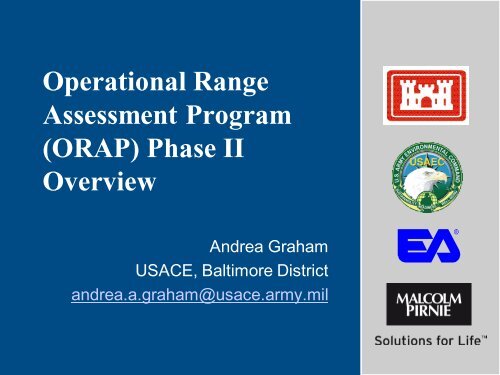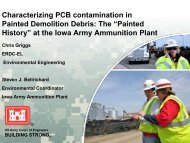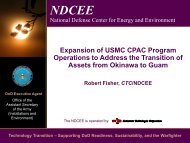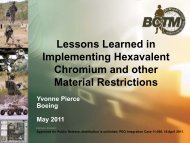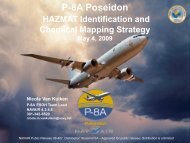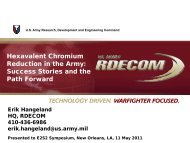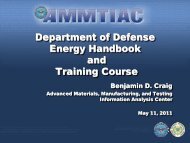Operational Range Assessment Program (ORAP) Phase II ... - E2S2
Operational Range Assessment Program (ORAP) Phase II ... - E2S2
Operational Range Assessment Program (ORAP) Phase II ... - E2S2
Create successful ePaper yourself
Turn your PDF publications into a flip-book with our unique Google optimized e-Paper software.
<strong>Operational</strong> <strong>Range</strong><br />
<strong>Assessment</strong> <strong>Program</strong><br />
(<strong>ORAP</strong>) <strong>Phase</strong> <strong>II</strong><br />
Overview<br />
Andrea Graham<br />
USACE, Baltimore District<br />
andrea.a.graham@usace.army.mil
<strong>Operational</strong> <strong>Range</strong> <strong>Assessment</strong> <strong>Program</strong><br />
Background<br />
• Mission<br />
• Establish “information excellence” to support the<br />
Army’s <strong>Range</strong> Sustainment <strong>Program</strong>.<br />
• Intent<br />
• Keep ranges open and available for testing and<br />
training.<br />
• Ensure people on and off Army installations are not<br />
drinking water contaminated by explosives.<br />
• Address regulatory and public concerns.
<strong>ORAP</strong> <strong>Assessment</strong>s<br />
use a phased<br />
approach and are<br />
based on<br />
Source – Receptor<br />
Interactions
<strong>Phase</strong> <strong>II</strong> Quantitative <strong>Assessment</strong><br />
• U.S. Army Public Health Command (Provisional) <strong>Phase</strong> <strong>II</strong><br />
Approach<br />
• Develop installation-specific HSP and APPs<br />
• Develop DQOs<br />
• Develop QAPPs using UFP-QAPP<br />
• Identify and address applicable SW and GW pathways only<br />
• Develop detailed Viable Pathway CSMs (discussion and<br />
illustration)<br />
- Incorporate non-range influences and degradation<br />
- Select effective sample locations<br />
• GW sampling at/near sources (not on impact areas) or exposure<br />
points<br />
• SW sampling<br />
- Account for temporal variability (wet/dry seasons, high/low flow events)<br />
- Use SW decision flow chart
<strong>Phase</strong> <strong>II</strong> Quantitative <strong>Assessment</strong><br />
• USAPHC (Provisional) <strong>Phase</strong> <strong>II</strong> Approach (continued)<br />
• Ecological Risk <strong>Assessment</strong>s – aquatic receptors only<br />
- Background and 95% UCL of mean results vs. screening levels<br />
comparison<br />
- Benthic macroinvertebrate surveys – false Positive / Negative<br />
• Human Health Risk Evaluations<br />
- Initial data screening – direct comparison to screening levels<br />
- Quantitative data screening – determine need for HHRA<br />
• Referred categorization must be based on Risk <strong>Assessment</strong> results –<br />
not just on <strong>Phase</strong> <strong>II</strong> data
<strong>Phase</strong> <strong>II</strong> <strong>ORAP</strong><br />
• ACSIM has overall Army responsibility for <strong>Operational</strong> <strong>Range</strong><br />
<strong>Assessment</strong> <strong>Program</strong> including funding and guidance.<br />
• G3 provides HQDA level operator input.<br />
• AEC and NGB are the <strong>Program</strong> Managers for <strong>Phase</strong> <strong>II</strong><br />
<strong>Assessment</strong>s.<br />
• USAPHC (Provisional) will provide technical oversight and QA.<br />
• Contract mechanism for <strong>Phase</strong> <strong>II</strong> <strong>Assessment</strong>s will consist of AE<br />
IDQ, Multiple Award Military Munitions, and Multiple Award<br />
Environmental Service contracts.<br />
• Total number of Active and Reserve installations requiring a <strong>Phase</strong><br />
<strong>II</strong> is 45 including the seven (7) pilot studies.<br />
• <strong>Phase</strong> <strong>II</strong> completion date is 2014.
<strong>ORAP</strong> <strong>Phase</strong> <strong>II</strong> Pilot<br />
USAG Fort Jackson / McCrady<br />
Training Center<br />
Rhonda Stone<br />
Malcolm Pirnie, Inc.<br />
rstone@pirnie.com<br />
© 2010 Malcolm Pirnie, Inc. All Rights Reserved
Installation Overview / Fast Facts<br />
• Fort Jackson -<br />
• Army owned/operated 36,971 acres<br />
(+15,267 acres operated by SCARNG)<br />
• Used 1917 to present for Basic & Advanced<br />
Infantry Training<br />
• 29,475 operational acres /<br />
16,471 categorized as Inconclusive*<br />
• 104 operational ranges /<br />
51 categorized as Inconclusive<br />
• McCrady Training Center -<br />
• Army owned/NGB operated<br />
• 15,267 acres in total<br />
• Used by SCARNG since 1943<br />
• 14,895 operational acres /<br />
12,243 categorized as Inconclusive*<br />
• 62 operational ranges /<br />
48 categorized as Inconclusive*<br />
* Inconclusive – Existing information is either insufficient to make a source-receptor interaction determination or<br />
indicates a potential for such interaction to be occurring.
Surface Water System Study Overview<br />
• Watersheds<br />
• Gills Creek<br />
• Colonels Creek<br />
• Cedar Creek<br />
• Mill Creek *<br />
• Sampling Events<br />
• Wet Season A + B –<br />
April Storm - May<br />
• Dry Season A + B - July<br />
• Surface Water Analysis<br />
• Explosives by EPA 8095M<br />
• Dissolved Metals by EPA 1638M<br />
• Perchlorate by EPA 6850<br />
• Sediment Analysis<br />
• Explosives by EPA 8330A<br />
• Metals by 6020A<br />
• Benthic Macroinvertebrates<br />
• Explosives by EPA 8330A<br />
• Metals by 6020A
Surface Water System Study Results<br />
Colonels Creek<br />
• Surface Water MCOC<br />
• Antimony, lead, and zinc<br />
exceeded reference<br />
• None exceeded PAL at 95%<br />
UCL of mean<br />
• Sediment MCOC<br />
• Copper, lead, and zinc<br />
exceeded reference<br />
• None exceeded PAL at 95%<br />
UCL of mean<br />
• Benthic<br />
Macroinvertebrates<br />
• No indications of<br />
impairments<br />
Surface Water and Sediment<br />
MCOC<br />
MCOC Exceeding<br />
Reference<br />
MCOC Exceeding<br />
Project Action<br />
Levels at 95% UCL<br />
of the mean<br />
Antimony Surface Water Surface Water<br />
Copper Antimony None<br />
Lead<br />
Lead<br />
Tungsten Zinc Sediment<br />
Zinc<br />
None<br />
1,3,5-Trinitrobenzene<br />
1,3-Dinitrobenzene<br />
2,4,6-Trinitrotoluene<br />
2,4-Dinitrotoluene<br />
2,6-Dinitrotoluene<br />
2-Amino-4,6-Dinitrotoluene<br />
3,4-Dinitrotoluene (SW Only)<br />
4-Amino-2,6-Dinitrotoluene<br />
4-Nitroaniline (SD Only)<br />
HMX<br />
m-Nitrotoluene<br />
Nitrobenzene<br />
Nitroglycerine<br />
o-Nitrotoluene<br />
Perchlorate (SW Only)<br />
p-Nitrotoluene<br />
RDX<br />
Tetryl<br />
Sediment<br />
Copper<br />
Lead<br />
Zinc
Surface Water System Study Findings<br />
Colonels Creek Conceptual Site Model
Groundwater System Study Overview<br />
• Worst-Case Groundwater<br />
Investigation Area (Blue Outline)<br />
• Worst-Case based on munitions<br />
type and loading, & proximity to<br />
receptors<br />
• 2 Stages<br />
• Stage I (30 March – 20 May<br />
2009):<br />
- 7 Piezometers<br />
- 5 staff gauge / piezometer pairs<br />
- Groundwater elevation<br />
measurement<br />
Piezometer Locations
Groundwater System Study Overview<br />
• Stage <strong>II</strong> (27 May – 10 June 2009)<br />
• 5 Soil Borings and 1 Deep Monitoring Well<br />
• 26 depth-discrete groundwater samples<br />
• 20-foot intervals to approximately 150 feet<br />
AMSL<br />
• One existing supply well sampled<br />
• Analyses<br />
MCOC<br />
- Explosives by EPA 8095M<br />
- Perchlorate by EPA 6850<br />
- Total and dissolved metals (antimony, copper,<br />
lead, zinc, and tungsten) by EPA 200.8<br />
Water Quality<br />
- Hardness metals (calcium and magnesium) plus<br />
sodium by EPA E200.7<br />
- Anions (sulfate, chloride, and nitrate) by EPA<br />
300.0<br />
- Alkalinity by EPA 310.1/SM2320B<br />
- Total dissolved solids (TDS) by SM2450C<br />
Soil Boring Locations
• Geology<br />
Groundwater System Results<br />
– Predominantly sand (fine- to medium-grained, sub-angular quartz, micaceaous<br />
zones)<br />
– Frequent clay units, laterally discontinuous upper, potentially continuous lower<br />
clay unit present in all 5 soil borings<br />
• Shallow Groundwater<br />
Flow<br />
– Topography controlled flow<br />
– Radial flow west, south,<br />
and east from investigation<br />
area<br />
– Discharge of shallow<br />
groundwater to low order<br />
streams (Cedar Creek,<br />
Colonels Creek, Jumping<br />
Run Creek)
Groundwater System Results<br />
Areal Extent of Perchlorate and RDX Detections<br />
Groundwater<br />
Investigation Area<br />
ClO 4<br />
A’<br />
ClO 4<br />
Cross-Section<br />
Locations<br />
B<br />
RDX<br />
Down-Gradient<br />
Receptors<br />
ClO 4<br />
ClO 4<br />
A<br />
B’<br />
1600 feet
Groundwater System Results<br />
• RDX:<br />
• 29 Samples Collected<br />
• 3 Detections in soil boring SB-3<br />
• 0.064 µg/L to 0.17 µg/L<br />
• All < PAL (6.1 µg/L) but 2<br />
above LRU (0.1 µg/L)<br />
• Perchlorate:<br />
• 29 Samples Collected<br />
• 7 Detections in 3 soil borings (SB-2,<br />
SB-4, and SB-5), and Weston Lake<br />
Well<br />
• 0.11 µg/L to 0.21 µg/L<br />
• All < PAL (15 µg/L) and
Overall <strong>Phase</strong> <strong>II</strong> Recommendations –<br />
Fort Jackson/McCrady Training Center<br />
<strong>Phase</strong> <strong>II</strong> Recommendations
<strong>ORAP</strong> <strong>Phase</strong> <strong>II</strong> Pilot<br />
Fort A.P. Hill<br />
Dave Mercadante<br />
EA Engineering, Science, and Technology<br />
dmercadante@eaest.com
Installation Overview / Fast Facts<br />
Fort A.P. Hill, Virginia<br />
• U.S. Army owned/operated<br />
• Active since 1941<br />
• 228 operational ranges<br />
• 74,262 acres<br />
<strong>Phase</strong> I Conclusions<br />
• Unlikely – 128 operational ranges, 47,641 acres<br />
• Inconclusive - (insufficient info regarding off range source-receptor<br />
interaction) 100 operational ranges, 26,621 acres
Piloting the Protocol<br />
• The identified sources, pathways, and receptors at installation allow full<br />
implementation of Technical Protocol<br />
• Training history means typical programmatic constituents potentially present on<br />
site<br />
• Main programmatic transport pathways identified from multiple source types<br />
- Well defined surface water flow and discharge points for multi-seasonal sampling<br />
- Groundwater sampling at both source discharge and potential exposure points<br />
- Habitat conditions present for testing application of benthic macroinvertebrate dip net<br />
sampling<br />
• Site location allows comparisons of protocol application between Fort A.P.<br />
Hill and USAPHC pilot site in Virginia<br />
• Site is easily accessible for evaluation by USAEC, USAPHC, and USACE<br />
program managers and technical oversight
Surface Water System Approach<br />
‣Worst Case Approach - Heaviest Usage<br />
‣Multi-Seasonal Sampling Events<br />
BMI Composite Samples<br />
‣Five Representative Watersheds<br />
‣Weight of Evidence Evaluation<br />
Composite Surface<br />
Water Samples<br />
Composite<br />
Sediment<br />
Samples
Surface Water System Approach
Surface Water System Results<br />
Surface Water - 95 UCLM for all analytes below background and/or human<br />
and ecological screening criteria at range/installation boundary<br />
Sediment - All analytes below background and/or ecological screening<br />
criteria at range/installation boundary.<br />
Benthic -Diverse, optimal habitats identified - no statistical difference<br />
versus background – critters are just fine<br />
Recent training below sampling locations adds new source component<br />
Currently revising technical approach to evaluate new source
Groundwater Approach<br />
‣Surficial aquifer wells at installation<br />
boundary designed to mimic potential<br />
receptor wells – 2 Wells per watershed<br />
Surficial Aquifer Wells<br />
‣Existing deeper production wells<br />
sampled to evaluate potential surfical to<br />
deep migration – 4 Wells<br />
Refined Shallow Aquifer CSM
Groundwater Approach
Groundwater Results<br />
All transportable analytes below background<br />
and/or human screening criteria at<br />
range/installation boundary in surficial<br />
aquifer and within the deeper production<br />
wells<br />
Lithology indicated low hydraulic conductivity<br />
in surficial aquifer even near surface water<br />
bodies<br />
Data evaluation complete – report<br />
development underway
Lessons Learned in Proving the Concept<br />
• Application of Worst Case Scenario application<br />
• Similarities in models of source, pathway, and receptor between<br />
watersheds allowed for a focused approach<br />
• Establishing a baseline for storm event sampling<br />
• Installation of rain gauges, transducers and barometers in multiple<br />
watersheds identified parameters necessary for true storm transport<br />
• Comparison of multi-seasonal benthic sampling results<br />
• Multi-seasonal approach added value – very dry “dry” season<br />
• BMI habitat and SEM-AVS sediment analysis provided additional weight<br />
of evidence to support analytical data<br />
• Benefits of USEPA Method 1638 - only method to achieve QL 3x<br />
below screening criteria at site specific hardness


